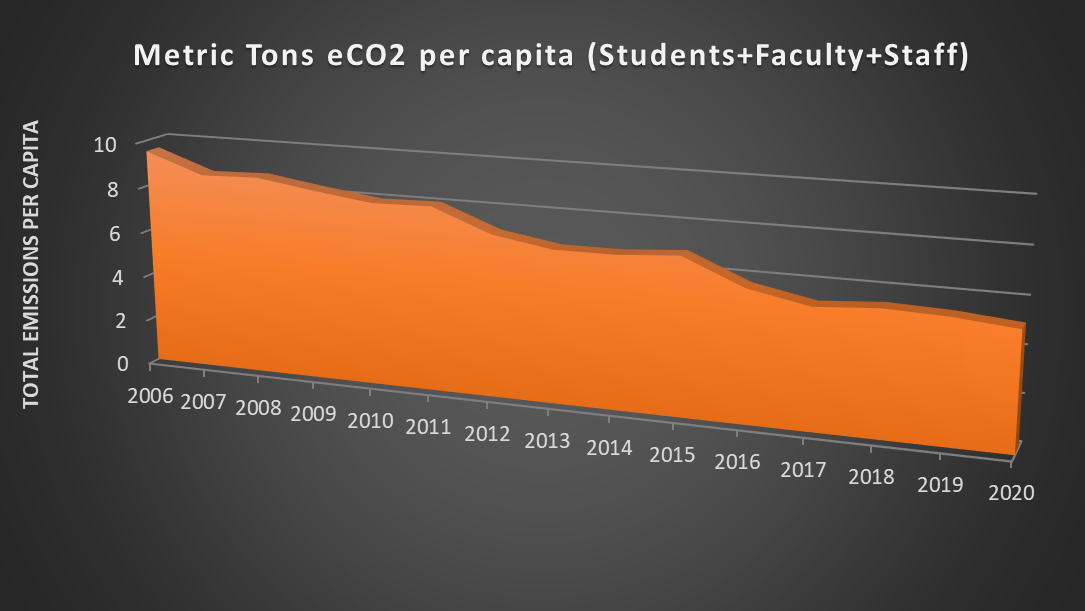UofL's Carbon Emissions Rise, Reinvestment Needed
 In 2008, UofL became a signatory to the American College & University Presidents’ Climate Commitment, which is now known simply as the Carbon Commitment. As a member of the Climate Leadership Network, the University of Louisville is committed to reducing greenhouse gas (GHG) emissions with the ultimate goal of achieving carbon neutrality by 2050 at the latest.
In 2008, UofL became a signatory to the American College & University Presidents’ Climate Commitment, which is now known simply as the Carbon Commitment. As a member of the Climate Leadership Network, the University of Louisville is committed to reducing greenhouse gas (GHG) emissions with the ultimate goal of achieving carbon neutrality by 2050 at the latest.
After benchmarking our carbon footprint with our 2008 Greenhouse Gas Emissions Baseline Inventory, on September 15, 2010, UofL released its Climate Action Plan, a comprehensive roadmap for reducing our emissions down to net zero. A summary of the Plan and a link to the full document can be found here. The Sustainability Council coordinates UofL's Climate Action Planning as well as the reporting of our greenhouse gas emissions.
 Our efforts to implement our Climate Action Plan had been paying off for many years, as we made progress toward our goal of climate neutrality. However, on May 1, 2018, UofL released its 2017 Greenhouse Gas Emissions Report, which documents that, following significant improvement in 2016, our emissions actually increased 11% in 2017, knocking us off track from achieving our first milestone goal of a 20% emissions reduction by 2020 from our 2008 baseline. In 2016, we stood at an 18.69% reduction from the 2008 baseline. In 2017, we are back down to a 13.51% reduction. We must cut emissions another 6.5% to achieve our goal of a 20% reduction by 2020.
Our efforts to implement our Climate Action Plan had been paying off for many years, as we made progress toward our goal of climate neutrality. However, on May 1, 2018, UofL released its 2017 Greenhouse Gas Emissions Report, which documents that, following significant improvement in 2016, our emissions actually increased 11% in 2017, knocking us off track from achieving our first milestone goal of a 20% emissions reduction by 2020 from our 2008 baseline. In 2016, we stood at an 18.69% reduction from the 2008 baseline. In 2017, we are back down to a 13.51% reduction. We must cut emissions another 6.5% to achieve our goal of a 20% reduction by 2020.
This is a troubling development, but it is not unfamiliar territory for UofL. We have been here before and we have righted our ship before. We saw a similar increase in emissions from 2013 to 2015, and took action to reverse the trend. In 2016, by continuing to invest in efficiency and behavior change, the university was able to achieve a 7.2% reduction of carbon emissions in one year. This was a vital investment for the sake of our students’ futures, and, indeed, for our common future on this one shared planet.
Our efforts to implement our Climate Action Plan (CAP) had been paying off, thanks to sustained investment of resources and attention in fiscal years 2011-2017. However, a troubling reversal of progress occurred in the last year during which the university’s financial crisis resulted in a 100% budget cut for Climate Action Plan implementation. A renewed investment of resources and leadership can get us back on track in the years to come.
Fortunately, over the long-term, we have reduced our greenhouse gas (GHG) emissions, even as we continue to grow in terms of physical size, campus population, and budgetary expenditures.
From 2006 to 2017, we estimate that UofL’s net carbon emissions have declined nearly 20% from 236,101 to 189,022 metric tons/year.
Yet this is no time to rest on our laurels. In fact, the most important finding of this inventory is that renewed investment will be required to make further progress and to meet our targets.
UofL has made progress, but must reinvest if we are to achieve our first milestone goal of a 20% reduction in emissions from our 2008 baseline by 2020. In 2017, we stood at an 13.51% reduction from the 2008 baseline. UofL decreased emissions by 29,518 metric tons of CO2 equivalent per year since 2008. According to the EPA's greenhouse gas equivalencies calculator, this translates to:
- Taking 6,321 cars off the road, or 72,348,039 miles of driving, or 3,321,481 gallons of gasoline burned;
- 10,285 tons (or 1,471 garbage trucks) of waste recycled instead of landfilled;
- Emission from 3,187 average U.S. homes’ annual energy use;
- 161 rail cars worth of coal burned;
- 987,885 incandescent lamps switched to LEDs; or the
- Carbon sequestered by 34,768 acres of U.S. forests in one year (or 764,993 tree seedlings grown for 10 years).
 While this reduction is important and laudable, this is no time for complacency. We must remain vigilant, committed, and willing to invest resources in order maintain our progress and to ensure a sustained effort toward our ultimate goal of climate neutrality by 2050. We must continue to invest in emissions reduction, to innovate solutions that work in our unique urban setting, and to prioritize efficiency, behavior change, transportation alternatives and renewable energy.
While this reduction is important and laudable, this is no time for complacency. We must remain vigilant, committed, and willing to invest resources in order maintain our progress and to ensure a sustained effort toward our ultimate goal of climate neutrality by 2050. We must continue to invest in emissions reduction, to innovate solutions that work in our unique urban setting, and to prioritize efficiency, behavior change, transportation alternatives and renewable energy.
The most important steps that UofL needs to take in the near-term are:
- Reduce driving through a Transportation Demand Management Plan that invests in and incentivizes alternatives, caps parking, & transitions UofL from highly subsidized annual permits to market-rate, pay-per-use parking.
- Invest in large-scale renewable energy, behavior change, and energy efficiency measures beyond the scope of the existing performance contract.
- Explore carbon offsetting and sequestration solutions that would benefit our campus, community, and region.
 The reductions we’ve been able to achieve over the years have occurred in spite of the continued growth of our university in terms of budget, employees, students, land, and building space. We've documented reductions across the board in terms of emissions per student, per capita, per square foot of building space, and per dollar of operating budget.
The reductions we’ve been able to achieve over the years have occurred in spite of the continued growth of our university in terms of budget, employees, students, land, and building space. We've documented reductions across the board in terms of emissions per student, per capita, per square foot of building space, and per dollar of operating budget.
UofL has been on a bit of a roller coaster ride as we try to reduce our carbon footprint. Though our 2017 Report documents a sharp increase in emissions, our 2016 Greenhouse Gas Emissions Report, showed an encouraging decline following the two-year rise in emission documented in our 2015 Greenhouse Gas Emissions Inventory. That bad news, however, came on the heels of a very encouraging 2013 Greenhouse Gas Emissions Inventory, in which we estimated that emissions had dropped over 22% from 2006 to 2013 (from 246,929 to 191,823 metric tons of carbon dioxide equivalent emitted annually, an amount equal to taking 11,600 cars off the road).



